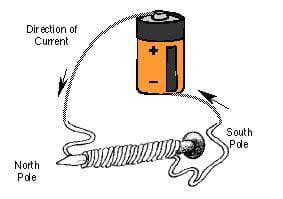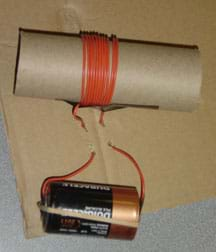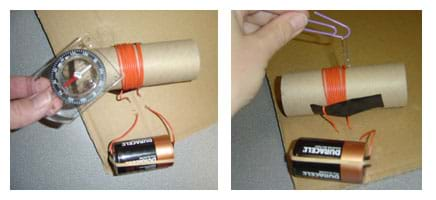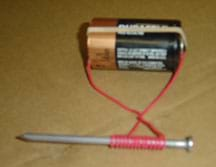Quick Look
Grade Level: 4 (3-5)
Time Required: 45 minutes
Expendable Cost/Group: US $2.00
Group Size: 2
Activity Dependency: None
Associated Informal Learning Activity: Creating an Electromagnet!
Subject Areas: Physical Science, Physics
NGSS Performance Expectations:

| 3-PS2-3 |
| 3-PS2-4 |
Summary
Student teams investigate the properties of electromagnets. They create their own small electromagnets and experiment with ways to change their strength to pick up more paperclips. Students learn about ways that engineers use electromagnets in everyday applications.
Engineering Connection
Engineers design electromagnets, which are a basic part of motors. Electromagnetic motors are a big part of everyday life, as well as industries and factories. We may not even realize that we interact with electromagnets on a daily basis as we use a wide variety of motors to make our lives easier. Common devices that use electromagnetic motors are: refrigerators, clothes dryers, washing machines, dishwashers, vacuum cleaners, sewing machines, garbage disposals, doorbells, computers, computer printers, clocks, fans, car starters, windshield wiper motors, electric toothbrushes, electric razors, can openers, speakers, music or tape players, etc.
Learning Objectives
After this activity, students should be able to:
- Relate that electric current creates a magnetic field.
- Describe how an electromagnet is made.
- Investigate ways to change the strength of an electromagnet.
- List several items that engineers have designed using electromagnets.
Educational Standards
Each TeachEngineering lesson or activity is correlated to one or more K-12 science,
technology, engineering or math (STEM) educational standards.
All 100,000+ K-12 STEM standards covered in TeachEngineering are collected, maintained and packaged by the Achievement Standards Network (ASN),
a project of D2L (www.achievementstandards.org).
In the ASN, standards are hierarchically structured: first by source; e.g., by state; within source by type; e.g., science or mathematics;
within type by subtype, then by grade, etc.
Each TeachEngineering lesson or activity is correlated to one or more K-12 science, technology, engineering or math (STEM) educational standards.
All 100,000+ K-12 STEM standards covered in TeachEngineering are collected, maintained and packaged by the Achievement Standards Network (ASN), a project of D2L (www.achievementstandards.org).
In the ASN, standards are hierarchically structured: first by source; e.g., by state; within source by type; e.g., science or mathematics; within type by subtype, then by grade, etc.
NGSS: Next Generation Science Standards - Science
| NGSS Performance Expectation | ||
|---|---|---|
|
3-PS2-3. Ask questions to determine cause and effect relationships of electric or magnetic interactions between two objects not in contact with each other. (Grade 3) Do you agree with this alignment? |
||
| Click to view other curriculum aligned to this Performance Expectation | ||
| This activity focuses on the following Three Dimensional Learning aspects of NGSS: | ||
| Science & Engineering Practices | Disciplinary Core Ideas | Crosscutting Concepts |
| Ask questions that can be investigated based on patterns such as cause and effect relationships. Alignment agreement: | Electric, and magnetic forces between a pair of objects do not require that the objects be in contact. The sizes of the forces in each situation depend on the properties of the objects and their distances apart and, for forces between two magnets, on their orientation relative to each other. Alignment agreement: | Cause and effect relationships are routinely identified, tested, and used to explain change. Alignment agreement: |
| NGSS Performance Expectation | ||
|---|---|---|
|
3-PS2-4. Define a simple design problem that can be solved by applying scientific ideas about magnets. (Grade 3) Do you agree with this alignment? |
||
| Click to view other curriculum aligned to this Performance Expectation | ||
| This activity focuses on the following Three Dimensional Learning aspects of NGSS: | ||
| Science & Engineering Practices | Disciplinary Core Ideas | Crosscutting Concepts |
| Define a simple problem that can be solved through the development of a new or improved object or tool. Alignment agreement: | Electric, and magnetic forces between a pair of objects do not require that the objects be in contact. The sizes of the forces in each situation depend on the properties of the objects and their distances apart and, for forces between two magnets, on their orientation relative to each other. Alignment agreement: | Scientific discoveries about the natural world can often lead to new and improved technologies, which are developed through the engineering design process. Alignment agreement: |
Common Core State Standards - Math
-
Represent and interpret data.
(Grade
4)
More Details
Do you agree with this alignment?
-
Represent real world and mathematical problems by graphing points in the first quadrant of the coordinate plane, and interpret coordinate values of points in the context of the situation.
(Grade
5)
More Details
Do you agree with this alignment?
-
Graph points on the coordinate plane to solve real-world and mathematical problems.
(Grade
5)
More Details
Do you agree with this alignment?
International Technology and Engineering Educators Association - Technology
-
Students will develop an understanding of the relationships among technologies and the connections between technology and other fields of study.
(Grades
K -
12)
More Details
Do you agree with this alignment?
-
Energy comes in different forms.
(Grades
3 -
5)
More Details
Do you agree with this alignment?
-
Describe the properties of different materials.
(Grades
3 -
5)
More Details
Do you agree with this alignment?
State Standards
Colorado - Math
-
Visual displays are used to represent data.
(Grade
4)
More Details
Do you agree with this alignment?
-
Represent and interpret data.
(Grade
5)
More Details
Do you agree with this alignment?
-
Represent real world and mathematical problems by graphing points in the first quadrant of the coordinate plane, and interpret coordinate values of points in the context of the situation.
(Grade
5)
More Details
Do you agree with this alignment?
-
Graph points on the coordinate plane to solve real-world and mathematical problems.
(Grade
5)
More Details
Do you agree with this alignment?
Colorado - Science
-
Energy comes in many forms such as light, heat, sound, magnetic, chemical, and electrical
(Grade
4)
More Details
Do you agree with this alignment?
Materials List
Each group needs:
- nail, 3-inch (7.6 cm) or longer (made of zinc, iron or steel, but not aluminum)
- 2 feet (.6 m) insulated copper wire (at least AWG 22 or higher)
- D-cell battery
- several metal paperclips, tacks or pins
- wide rubber band
- Building an Electromagnet Worksheet
For each electromagnetic field station:
- cardboard toilet paper tube
- insulated copper wire (at least AWG 22 or higher), several feet (1 m)
- cardboard (~ 5 x 5 inches or 13 x 13 cm)
- clothespins or clamps (optional)
- masking tape
- rubber band
- 2-3 D-cell batteries
- 9-V (volt) battery
- several metal paperclips, tacks and/or pins
- extra batteries, if available: 6-V, 12-V, lantern batteries
- (optional) electrical tape
- 2 small orienteering compasses
For the entire class to share:
- wire cutters
- wire strippers
Worksheets and Attachments
Visit [www.teachengineering.org/activities/view/cub_mag_lesson2_activity1] to print or download.Pre-Req Knowledge
Some knowledge of magnetic forces (poles, attraction forces). Refer to the Magnetism unit, Lesson 2: Two Sides of One Force, for this information on electromagnets.
Introduction/Motivation
Today, we are going to talk about electromagnets and create our own electromagnets! First, can anyone tell me what an electromagnet is? (Listen to student ideas.) Well, an electromagnet's name helps tell us what it is. (Write the word electromagnet on the classroom board for students to see.) Let's break it down. The first part of the word, electro, sounds like electricity. The second part of the word, magnet, is what it sounds like—a magnet! So, an electromagnet is a magnet that is created by electricity.
The really important thing to remember today is that electricity can create a magnetic field. This may sound strange, because we're used to magnetic fields just coming from magnets, but it is really true! A wire that has electrical current running through it creates a magnetic field. In fact, the simplest electromagnet is a single wire that is coiled up and has an electric current running through it. The magnetic field generated by the coil of wire is like a regular bar magnet. If we put an iron (or nickel, cobalt, etc.) rod (perhaps a nail) through the center of the coil (see Figure 1), the rod becomes the magnet, creating a magnetic field. Where do we find the electricity for an electromagnet? Well, we can get this electricity a few ways, such as from a battery or a wall outlet.
We can make this magnetic field stronger by increasing the amount of electric current going through the wire or we can increase the number of wire wraps in the coil of the electromagnet. What do you think happens if we do both of these things? That's right! Our magnet will be even stronger!
Engineers use electromagnets when they design and build motors. Motors are in use around us everyday, so we interact with electromagnets all the time without even realizing it! Can you think of some motors that you have used? (Possible answers: Washing machine, dishwasher, can opener, garbage disposal, sewing machine, computer printer, vacuum cleaner, electric toothbrush, compact disc [CD] player, digital video disc [DVD] player, VCR tape player, computer, electric razor, an electric toy [radio-controlled vehicles, moving dolls], etc.)
Procedure
Before the Activity
- Gather materials and make copies of the Building an Electromagnet Worksheet.
- Set up enough Electromagnetic Field Stations to accommodate teams of two students each.
- As an alternative, conduct both parts of the activity as teacher-led class demonstrations.

- Prepare for Electromagnetic Field Stations: Wrap wire around a cardboard toilet paper tube 12-15 times to make a wire loop. Leave two long tails of wire hanging from the coil. Poke four holes in the cardboard. Weave the wire ends through the cardboard holes so that the card board tube and coil are attached to the cardboard (see Figure 2). Use clothespins, clamps or tape to secure the cardboard to a table or desk. Using masking tape or rubber band, connect one end of the coil wire to any battery, leaving the other end of the wire not connected to the battery. Place some pins, paperclips or tacks at the station. Also, place any other available extra batteries (6V, 12V, etc.) and two, small orienteering compasses at this station.
- Prepare for Building an Electromagnet: For this portion of the activity, either set up the materials at a station, or give them to pairs of students to work on at their desks.
- Set aside a few extra batteries for students to test their own electromagnets. These might include the 9-V batteries. You can make a 3-V battery setup by connecting 2 D-cells in series or a 4.5-V battery setup by connecting 3 D-cells in series.
- Cut one 2-ft (.6 m) piece of wire for each team. Using wire strippers, remove about ½ inch (1.3 cm) of insulation from both ends of each piece of wire.
With the Students: Electromagnetic Field Stations
- Divide the class into pairs of students. Hand out one worksheet per team.
- Working from the pre-activity setup (see Figure 2), in which one end of the coiled wire is attached to one end of the battery, have students connect the other end of the wire to the other end of the battery using tape or rubber band.
- To locate the magnetic field of the electromagnet, direct students to move the compass in a circle around the electromagnet, paying attention to the direction that the compass points (see Figure 3). Direct students to draw the battery, coil and magnetic field on their worksheets. Use arrows to show the magnetic field. Label the positive and negative ends of the battery and the poles of the magnetic field. What happens if you dangle a paperclip from another paperclip near the coil (see Figure 3)? (Answer: The dangling paperclip moves, changes direction and/or wobbles.)

- Next, reverse the connection of the electromagnet by changing both ends of the wire to the opposite ends of the battery. (When the direction of current is reversed in either a coil or electromagnet, the magnetic poles reverse—the north pole becomes the south pole, and the south pole becomes the north pole.) Use the compass to check the direction of the magnetic field. Make a second drawing. Dangle the paperclip near the coil again. What happens? (Answer: Again, the dangling paperclip moves, changes direction and/or wobbles.)
- Remove at least one end of the wire from the battery to conserve battery power.
- If time permits, use different batteries and observe any changes. A higher voltage translates to a greater current, and with more current, the electromagnet becomes stronger.
With the Students: Building an Electromagnet
- Make sure each student pair has the following materials: 1 nail, 2 feet (.6 m) of insulated wire, 1 D-cell battery, several paperclips (or tacks or pins) and a rubber band.
- Wrap the wire around a nail at least 20 times (see Figure 4). Ensure students wrap their nails tightly, leaving no gaps between the wires and not overlapping the wraps.
- Give the students several minutes to see if they can create an electromagnet on their own before giving them the rest of the instructions.
- To continue making the electromagnet, connect the ends of the coiled wire to each end of the battery using the rubber band to hold the wires in place (see Figure 4).

- Test the strength of the electromagnet by seeing how many paperclips it can pick up.
- Record the number of paperclips on the worksheet.
- Disconnect the wire from the battery after testing the electromagnet. Can the electromagnet pick up paperclips when the current is disconnected? (Answer: No)
- Test how varying the design of the electromagnet affects its strength. The two variables to modify are the number of coils around the nail and the current in the coiled wire by using a different size or number of batteries. To conserve the battery's power, remember to disconnect the wire from the battery after each test.
- Complete the worksheet; making a list of ways engineers might be able to use electromagnets.
- Conclude by holding a class discussion. Compare results among teams. Ask students the post-assessment engineering discussion questions provided in the Assessment section.
Vocabulary/Definitions
battery: A cell that carries a charge that can power an electric current.
current: A flow of electrons.
electromagnet: A magnet made of an insulated wire coiled around an iron core (or any magnetic material such as iron, steel, nickel, cobalt) with electric current flowing through it to produce magnetism. The electric current magnetizes the core material.
electromagnetism: Magnetism created by an electric current.
engineer: A person who applies her/his understanding of science and mathematics to create things for the benefit of humanity and our planet. This includes the design, manufacture and operation of efficient and economical structures, machines, products, processes and systems.
magnet: An object that generates a magnetic field.
magnetic field: The space around a magnet in which the magnet's magnetic force is present.
motor: An electrical device that converts electrical energy into mechanical energy.
permanent magnet: An object that generates a magnetic field on its own (without the help of a current).
solenoid: A coil of wire.
Assessment
Pre-Activity Assessment
Prediction: Ask students to predict what will happen when a wire is wrapped around a nail and electricity is added. Record their predictions on the classroom board.
Brainstorming: In small groups, have students engage in open discussion. Remind them that no idea or suggestion is "silly." All ideas should be respectfully heard. Ask the students: What is an electromagnet?
Activity-Embedded Assessment
Worksheet: At the beginning of the activity, hand out the Building an Electromagnet Worksheet. Have students make drawings, record measurements and follow along with the activity on their worksheets. After students finish the worksheet, have them compare answers with a peer or another pair, giving all students time to finish. Review their answers to gauge their mastery of the subject.
Hypothesize: As students make their electromagnet, ask each group what would happen if they changed the size of their battery. How about more coils of wire around the nail? (Answer: An electromagnet can be made stronger in two ways: increasing the amount of electric current going through the wire or increasing the number of wire wraps in the coil of the electromagnet.)
Post-Activity Assessment
Engineering Discussion Questions: Solicit, integrate and summarize student responses.
- What are ways an engineer might modify an electromagnet to change the strength of its magnetic field? Which modifications might be the easiest or cheapest? (Possible answers: Increasing the number of coils used in the solenoid [electromagnet] is probably the least expensive and easiest way to increase the strength of an electromagnet. Or, an engineer might increase the current in the electromagnet. Or, an engineer might use a metal core that is more easily magnetized.)
- How might engineers use electromagnets in separating recyclable materials? (Answer: Some of the metals in a salvage or recycling pile are attracted to a magnet and can be easily separated. Non-ferrous metals must go through a two-step process in which a voltage is applied to the metal to temporarily induce a current in it, which temporarily magnetizes the metal so it is attracted to the electromagnet for separation from non-metals.)
- What are some ways that engineers might be able to use electromagnets? (Possible answers: Engineers use electromagnets in the design of motors. For examples, see the possible answers to the next question.)
- How are electromagnets used in everyday applications? (Possible answers: Motors are in use around us everyday, for example, refrigerator, washing machine, dishwasher, can opener, garbage disposal, sewing machine, computer printer, vacuum cleaner, electric toothbrush, compact disc [CD] player, digital video disc [DVD] player, VCR tape player, computer, electric razor, an electric toy [radio-controlled vehicles, moving dolls], etc.)
Graphing Practice: Present the class with the following problems and ask students to graph their results (or the entire class' results). Discuss which variables made a bigger change in the strength of the electromagnet.
- Make a graph that shows how the electromagnet strength changed as you changed the number of wire coils in your electromagnet.
- Make a graph that shows how the strength of your electromagnet changed as the current changed (as you changed the battery size).
Safety Issues
The electromagnet can get quite warm, particularly at the terminals, so have students disconnect their batteries at frequent intervals.
Troubleshooting Tips
A high density of nail wraps is important to produce a magnetic field. If the wrapped nails are not acting as magnets, check students’ coil wraps to ensure they are not crisscrossed, and that the wraps are tight. Also, use thin gauge wire to enable more wraps along the length of the nail.
Iron nails work better than bolts since the bolt threads do not permit smooth wrapping of the copper wire, which may disrupt the magnetic field.
Avoid using batteries that are not fully charged. Partially discharged batteries will not generate a strong and observable magnetic reaction.
If the electromagnets get too warm, have students use rubber kitchen gloves to handle them.
Activity Extensions
Another way to vary the current in the electromagnet is to use wires of different gauges (thickness) or of different materials (for example: copper vs. aluminum). Ask students to test different wire types to see how this affects the electromagnet's strength. As a control, keep constant the number of coils and amount of current (battery) for all wire tests. Then, based on their rest results, ask students to make guesses about the resistances of the various wires.
Activity Scaling
- For lower grades, have students follow along with the teacher-led demonstration to create a simple electromagnet. Discuss the basic definition of an electromagnet and how electromagnets are used in everyday applications.
- For upper grades, have students investigate ways to change the strength of their electromagnets without giving them any hints or clues. Have students graph their worksheet data from varying the number of coils and/or battery size in their electromagnet.
Subscribe
Get the inside scoop on all things TeachEngineering such as new site features, curriculum updates, video releases, and more by signing up for our newsletter!More Curriculum Like This

Students learn more about magnetism, and how magnetism and electricity are related in electromagnets. They learn the fundamentals about how simple electric motors and electromagnets work. Students also learn about hybrid gasoline-electric cars and their advantages over conventional gasoline-only-pow...

Students are briefly introduced to Maxwell's equations and their significance to phenomena associated with electricity and magnetism. Basic concepts such as current, electricity and field lines are covered and reinforced. Through multiple topics and activities, students see how electricity and magne...

Students induce EMF in a coil of wire using magnetic fields. Students review the cross product with respect to magnetic force and introduce magnetic flux, Faraday's law of Induction, Lenz's law, eddy currents, motional EMF and Induced EMF.

Students investigate the properties of magnets and how engineers use magnets in technology. Specifically, students learn about magnetic memory storage, which is the reading and writing of data information using magnets, such as in computer hard drives, zip disks and flash drives.
Copyright
© 2004 by Regents of the University of ColoradoContributors
Xochitl Zamora Thompson; Joe Friedrichsen; Abigail Watrous; Malinda Schaefer Zarske; Denise W. CarlsonSupporting Program
Integrated Teaching and Learning Program, College of Engineering, University of Colorado BoulderAcknowledgements
The contents of this digital library curriculum were developed under grants from the Fund for the Improvement of Postsecondary Education (FIPSE), U.S. Department of Education, and National Science Foundation (GK-12 grant no 0338326). However, these contents do not necessarily represent the policies of the Department of Education or National Science Foundation, and you should not assume endorsement by the federal government.
Last modified: July 30, 2020









User Comments & Tips